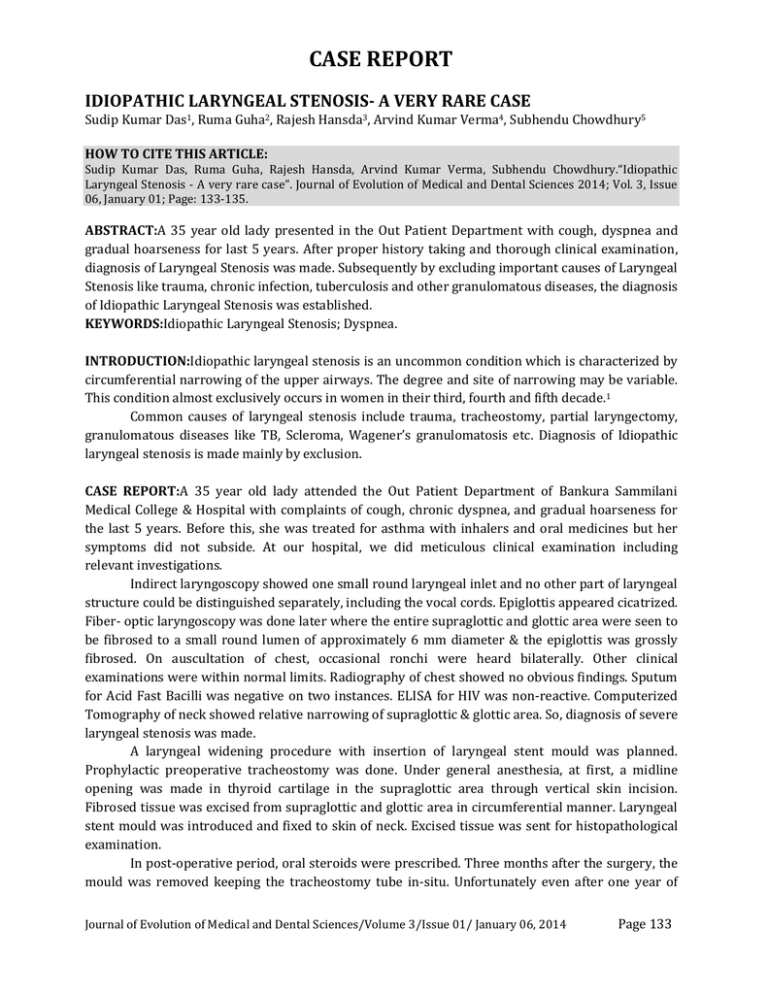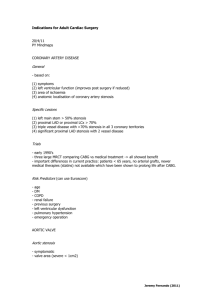“Idiopathic Laryngeal Stenosis - A very rare case”.
advertisement

CASE REPORT IDIOPATHIC LARYNGEAL STENOSIS- A VERY RARE CASE Sudip Kumar Das1, Ruma Guha2, Rajesh Hansda3, Arvind Kumar Verma4, Subhendu Chowdhury5 HOW TO CITE THIS ARTICLE: Sudip Kumar Das, Ruma Guha, Rajesh Hansda, Arvind Kumar Verma, Subhendu Chowdhury.“Idiopathic Laryngeal Stenosis - A very rare case”. Journal of Evolution of Medical and Dental Sciences 2014; Vol. 3, Issue 06, January 01; Page: 133-135. ABSTRACT:A 35 year old lady presented in the Out Patient Department with cough, dyspnea and gradual hoarseness for last 5 years. After proper history taking and thorough clinical examination, diagnosis of Laryngeal Stenosis was made. Subsequently by excluding important causes of Laryngeal Stenosis like trauma, chronic infection, tuberculosis and other granulomatous diseases, the diagnosis of Idiopathic Laryngeal Stenosis was established. KEYWORDS:Idiopathic Laryngeal Stenosis; Dyspnea. INTRODUCTION:Idiopathic laryngeal stenosis is an uncommon condition which is characterized by circumferential narrowing of the upper airways. The degree and site of narrowing may be variable. This condition almost exclusively occurs in women in their third, fourth and fifth decade.1 Common causes of laryngeal stenosis include trauma, tracheostomy, partial laryngectomy, granulomatous diseases like TB, Scleroma, Wagener’s granulomatosis etc. Diagnosis of Idiopathic laryngeal stenosis is made mainly by exclusion. CASE REPORT:A 35 year old lady attended the Out Patient Department of Bankura Sammilani Medical College & Hospital with complaints of cough, chronic dyspnea, and gradual hoarseness for the last 5 years. Before this, she was treated for asthma with inhalers and oral medicines but her symptoms did not subside. At our hospital, we did meticulous clinical examination including relevant investigations. Indirect laryngoscopy showed one small round laryngeal inlet and no other part of laryngeal structure could be distinguished separately, including the vocal cords. Epiglottis appeared cicatrized. Fiber- optic laryngoscopy was done later where the entire supraglottic and glottic area were seen to be fibrosed to a small round lumen of approximately 6 mm diameter & the epiglottis was grossly fibrosed. On auscultation of chest, occasional ronchi were heard bilaterally. Other clinical examinations were within normal limits. Radiography of chest showed no obvious findings. Sputum for Acid Fast Bacilli was negative on two instances. ELISA for HIV was non-reactive. Computerized Tomography of neck showed relative narrowing of supraglottic & glottic area. So, diagnosis of severe laryngeal stenosis was made. A laryngeal widening procedure with insertion of laryngeal stent mould was planned. Prophylactic preoperative tracheostomy was done. Under general anesthesia, at first, a midline opening was made in thyroid cartilage in the supraglottic area through vertical skin incision. Fibrosed tissue was excised from supraglottic and glottic area in circumferential manner. Laryngeal stent mould was introduced and fixed to skin of neck. Excised tissue was sent for histopathological examination. In post-operative period, oral steroids were prescribed. Three months after the surgery, the mould was removed keeping the tracheostomy tube in-situ. Unfortunately even after one year of Journal of Evolution of Medical and Dental Sciences/Volume 3/Issue 01/ January 06, 2014 Page 133 CASE REPORT surgery the patient could not be decanulated. Histopathological examination report was inconclusive. DISCUSSION:Idiopathic Laryngeal Stenosis is a very rare entity with preponderance amongst females. It may be due to hormonal influences leading to unremitting inflammatory process with inconclusive histopathology. Most of the case description of Idiopathic Laryngeal Stenosis shows a delayed presentation of an embryonic pathology. This results in failure of recanalization of larynx during tenth week of gestation which causes various degrees of web and ring formation.2 Generally Idiopathic Laryngo-Tracheal Stenosis has a very slow progressive course, at least of two years3. Very often patients erroneously receive treatment for asthma for years. 4 Our patient was also symptomatic for 5 years before reporting to us and also treated erroneously for asthma with inhalers. Histopathology of excised tissue of our patient did not reflect any feature of infection or any granulomatous diseases like tuberculosis, Wagener’s granulomatosis or malignancy. Only non-specific inflammatory changes were found. Choice of treatment may be conservative or surgical, depending upon diameter, length, location of lesion and health status of the patient. Smith & Elstad showed in their ‘Randomized Control Trial’ that superior results were achieved with application of Mitomycin C given three to four weeks apart after airway radial incision and dilatation compared to patients receiving a single application of Mitomycin C 5. Mitomycin C modulates wound healing and scarring by fibroblast proliferation and synthesis of extracellular matrix protein. Cheu & Chen et al6 reported laryngotracheal reconstruction with costal cartilage grafting. ACKNOWLEDGEMENT:Dr. Jhuma Biswas for drafting and revising the manuscript. Dr. SoumyaKanti Sen for providing detailings of the manuscript. REFERENCES: 1. Prakash U B, Uncommon causes of cough: ACCP evidence based clinical practice guidelines. Chest.2006; 129 (1 suppl.): 206 -209. 2. Muller C D Subglottic Stenosis, Grand Rounds UTMB –Dept ofOtolaryngology. UTMB; 2002: 117. 3. Grillo HCMark EJ, Mathisen DJ, Wain J C, Idiopathic laryngotracheal stenosis: the entity and its management. Ann ThoracicSurg. 4. Durrani J, Durrani J, Chaudhury SU, Yousaf S, Idiopathic laryngotracheal Stenosis: Presentation with stridor and wheezing: Nishtar Medical JournalJan-March 2010; 2: 33-37. 5. Smith M E, ElstadM, Mitomycin C and the endoscopic treatment of laryngotracheal stenosis: are two applications better than one? Laryngoscope2009; 119 (2): 272 -83. 6. Cui P Chen W. Treatment of Idiopathic Laryngotracheal stenosiswith laryngotracheal reconstruction, JLaryngolOtol 2009; 123(ii): 1233-6. Journal of Evolution of Medical and Dental Sciences/Volume 3/Issue 01/ January 06, 2014 Page 134 CASE REPORT CT Scan of Neck Coronal View CT Scan of Neck Sagittal View Fibreopticlaryngoscopic view of the patient AUTHORS: 1. Sudip Kumar Das 2. Ruma Guha 3. Rajesh Hansda 4. Arvind Kumar Verma 5. Subhendu Chowdhury PARTICULARS OF CONTRIBUTORS: 1. Assistant Professor, Department of ENT, Bankura Sammilani Medical College & Hospital, Bankura, West Bengal, India. 2. Clinical Tutor, Department of ENT, Bankura Sammilani Medical College & Hospital, Bankura, West Bengal, India. 3. Assistant Professor, Department of ENT, Bankura Sammilani Medical College & Hospital, Bankura, West Bengal, India. 4. 5. Clinical Tutor, Department of ENT, Bankura Sammilani Medical College & Hospital, Bankura, West Bengal, India. Senior Resident, Department of ENT, Bankura Sammilani Medical College & Hospital, Bankura, West Bengal, India. NAME ADDRESS EMAIL ID OF THE CORRESPONDING AUTHOR: Dr.Ruma Guha, ‘Maya Vila’, Plot – 108, Sec: A, Metropolitan Co-Operative Housing Society Ltd., Kolkata – 700105. Email-rumaent@rediffmail.com Date of Submission: 07/12/2013. Date of Peer Review: 08/12/2013. Date of Acceptance: 17/12/2013. Date of Publishing: 02/01/2014 Journal of Evolution of Medical and Dental Sciences/Volume 3/Issue 01/ January 06, 2014 Page 135






